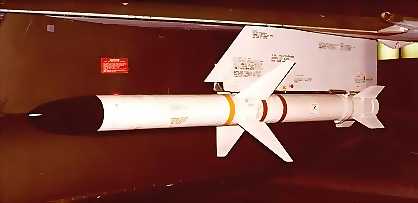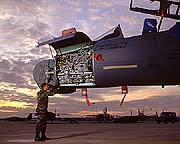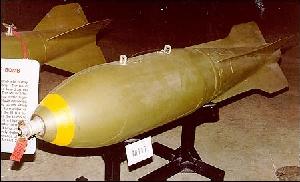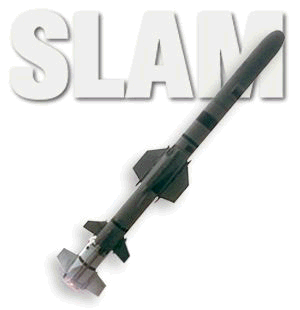

Primary function: Antiradiation missile that homes in on hostile antiaircraft radars.
Propulsion: Solid-fuel rocket
Length: 10 feet (3.05 meters)
Weight: 390 pounds (177.06 kilograms)
Diameter: 8 inches (20.32 centimeters)
Warhead: Conventional
Span: 3 feet (.914 meters)
Guidance: Passive radar homing
Platforms: A-4 Skyhawk, A-6 Intruder
Unit Replacement Cost: $32,000.00
Features: The Shrike was developed by the Naval Weapons Center at China Lake in 1963. It
is an antiradiation missile designed to home in on hostile antiaircraft radars. It is
currently used by U.S. and Israeli air forces.

The APG-70 is a multimode radar that provides air-to-air and air-to-surface capabilities. It is an upgrade of the APG-63, designed for greater reliability and easier maintenance. Gate array technology pioneered by Hughes Aircraft enables the APG-70 to incorporate modes not available in earlier radars while providing greatly enhanced operational capabilities in other modes. The APG-70 is employed on late model F-15Cs, Ds, and Es and on the F-15I and the F-15S.
Courtesy Hughes Aircraft
M117
General Purpose Bomb

The M117 is a 750-pound general purpose bomb which may be employed in several
different configurations. The basic M117 dates from the Korean War and uses a low-drag
tail fin for medium and high-altitude deliveries. The M117R (Retarded) uses a special fin
assembly providing either high-drag or low-drag release options. For low altitude
deliveries, the tail assembly opens four large drag plates which rapidly slow the bomb and
allow the aircraft to escape its blast. The M117 (Destructor) looks similar to the M117R
but uses a magnetic influence fuze which enables the bomb to function as a mine. The M117D
is released in a high-drag configuration for ground implant or shallow water mining. It
detonates when an object passing near the bomb triggers the fuze. The M117 series was used
extensively during the Vietnam War, and B-52G aircraft dropped thousands of tons of M117
and M117R bombs during Operation Desert Storm.
Courtesy U. S. Air Force Museum
AGM-84 E (SLAM)

The Standoff Land Attack Missile (SLAM) is a derivative of the AGM-84A Harpoon anti-ship missile designed to engage ships
and land targets. SLAM is launched from carrier-based aircraft.
The SLAM shares common control, warhead, and sustainer sections with the Harpoon, but it
also has a Rockwell-Collins Global Positioning System (GPS) that allows the missile's path
to be updated or corrected after launch. In addition to using Harpoon components, SLAM
adopts the Imaging Infrared (IIR) seeker of the AGM-65 Maverick and the data link of the
AGM-62 Walleye. When the seeker is activated, the pilot/weapons officer receives a video
image of the target and can select an aiming point on the target for a precision strike.
The missile then operates autonomously. The missile can also be controlled from a plane
other than the firing plane, providing the capability to attack targets of opportunity
selected by mid-course observation through the missile's seeker. In tests, the SLAM was
launched from an A-6E and locked on to target by an accompanying A-7 pilot. The
same aircraft combination may have been used during its first operational flights against
Iraqi targets in January 1991, although 2 F/A-18 Hornets have also successfully launched
and guided the SLAM.
Initial Operating Capability (IOC) of the SLAM was in 1990. First operational use on 19
January 1991 as part of Operation Desert Storm.
Specifications:
Manufacturer: Douglas Missile Systems
Weight:
Missile: 1366 lbs.
Warhead: 500 lbs.
Length: 14.6 ft.
Diameter: 13 inches
Wingspan: 3 ft.
Guidance: IIR-guided
Propulsion: Teledyne Continental CAE-J402-CA-400 turbojet sustainer
Performance:
Speed: Mach 0.85
Range: Over-the-horizon, in excess of 60 nautical miles
Warhead: DESTEX blast/fragmentation high-explosve with preselected instantaneous or dealy
fuzing
| Standoff Land Attack Missiles (SLAM) SLAM provides the U.S. Navy with surgical strike capability against high-value, fixed land targets, ships in port or ships at sea. SLAM can be launched from safe standoff ranges in excess of 50 nautical miles. Once launched, the missile may be controlled from even greater ranges. SLAM combines the airframe, propulsion and control systems of the Harpoon missile with existing guidance systems -- an imaging infrared seeker, data link and a Global Positioning System receiver/processor. Using proven, off-the-shelf components helped make SLAM available much sooner than any other comparable standoff weapon system. In August 1994, McDonnell Douglas was awarded a U.S. Navy contract for Engineering and Manufacturing Development on the SLAM Expanded Response (SLAM ER) program. SLAM ER will incorporate a number of improvements to the baseline SLAM. These retrofit upgrades include planar wings to improve range and aerodynamic performance; an improved warhead to increase penetration and lethality against hardened targets; and software improvements that will make it easier for the missile controller to place the SLAM seeker crosshairs on the target aimpoint. While the missile is in flight, the Global Positioning System receiver/processor updates the missile's inertial navigation system. This helps to ensure that the missile's imaging infrared seeker is pointed directly at the target. When the infrared seeker is activated, it sends a video image to the pilot or bombardier/navigator, who selects a specific aimpoint on the target. After the pilot or bombardier/navigator locks the seeker onto the target, the missile makes an autonomous precision strike that minimizes damage to surrounding areas. Automated mission planning for SLAM entered fleet use with the U.S. Navy in June 1996. Automated mission planning reduces planning time to under 30 minutes from roughly three hours using the old chart-and-calculator method. Automated mission planning automatically validates the mission and employs a user friendly, interactive checklist to ensure that no steps are overlooked. SLAM automated mission planning will be modified for the SLAM ER program. SLAM is currently launched from F/A-18 and A-6E aircraft and controlled from F/A-18, A-6E and A7 aircraft. The first production SLAM was delivered to the U.S. Navy in November 1988. Production of 600 SLAM missiles was completed in 1996. |
| Standoff Land Attack Missiles Expanded Response (SLAM ER)
Boeing, the largest cruise missile producer in the world, has produced more than 8,600 cruise missiles for the U.S. Department of Defense. The Harpoon, the company's flagship missile, is currently sold to 24 countries. An affordable inventory upgrade, SLAM ER will incorporate a number of improvements to the baseline SLAM, a derivative of the Harpoon anti-ship missile. These retrofit upgrades include planar wings to improve range and aerodynamic performance, an improved warhead to increase penetration and lethality against hardened targets, and software improvements that will make it easier for the control aircraft to designate track on the target aimpoint. SLAM ER provides the U.S. Navy with surgical strike capability against high-value, fixed land targets, ships in port, or ships at sea. Designed for deployment from carrier-based and land-based aircraft, SLAM ER can easily be adapted for ship launch. SLAM ER can be launched from safe standoff ranges of more than 150 nautical miles. While the missile is in flight, the Global Positioning System receiver/processor updates the missile's inertial navigation system. This helps to ensure that the missile's imaging infrared seeker is pointed directly at the target. When the infrared seeker is activated, it sends a video image to the pilot, who selects a specific aimpoint on the target. After the pilot locks the seeker onto the target, the missile makes an autonomous precision strike that minimizes damage to surrounding areas. The McDonnell Douglas-developed Automatic Target Recognition System will provide even greater warfighting capability for SLAM ER in the future. SLAM ER is manufactured by Boeing in St. Charles, Mo. |
Armament | U.S. Fighter | 'Aces Hall of Fame